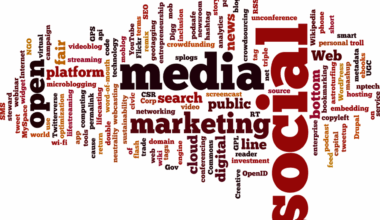Integrating Finance and Marketing Through Advanced Tech Stacks
In today’s rapidly evolving business landscape, integrating finance and marketing is essential for driving growth. Tech stacks are pivotal in creating seamless communication between these crucial domains. An effective marketing technology stack comprises tools that enhance collaboration, streamline processes, and promote data-driven decision-making. By fusing financial insights with marketing strategies, businesses can optimize budget allocations and improve campaign ROI. Advanced analytics and real-time reporting can significantly boost efficiency, allowing teams to swiftly pivot their tactics based on financial performance. Moreover, with the rise of artificial intelligence, marketers can better predict customer behavior while aligning strategies closely with financial objectives. Utilizing platforms such as CRM and ERP within the tech stack creates a holistic view of customer data, spending patterns, and financial forecasts. This integration ultimately fosters better alignment between revenue generation and marketing efforts, ensuring both departments work toward common goals. Consequently, embracing a robust marketing technology stack not only enhances internal collaboration but also drives ultimately improved business outcomes, positioning organizations ahead of their competition. Together, finance and marketing can achieve greater synergy through technology by leveraging powerful tools to meet objectives efficiently.
Data quality is paramount for an effective marketing technology stack. Poor quality data can lead to misguided strategies and financial miscalculations. Companies must invest in data cleansing processes and solutions to ensure accuracy across all touchpoints. This is where a Customer Data Platform (CDP) comes into play, aggregating data from diverse sources into a unified system. A CDP enables both marketing and finance teams to access reliable data, providing insights that enhance campaign effectiveness and improve budgeting considerations. Integration of data visualization tools helps these departments visualize their findings, transforming numbers into actionable insights. Businesses can capitalize on this data richness by developing targeted campaigns that reflect customer preferences, while also matching these endeavors with financial goals. Additionally, implementing tracking systems allows teams to monitor how marketing spend aligns with financial outcomes efficiently. When marketing and finance work with accurate data, they can formulate strategies that are both innovative and financially viable. As organizations prioritize data governance, a well-integrated stack will pave the way for informed decision-making that fosters sustainable growth, resulting in marketing initiatives that resonate strongly with target audiences.
The Role of Automation in Marketing and Finance
Automation plays a transformative role in bridging the gap between finance and marketing departments. Implementing automated solutions allows for efficient task management and reduced error margins in financial reporting and marketing campaigns alike. This allows teams to focus on strategic initiatives instead of spending time on repetitive tasks. For instance, marketing automation tools help in executing campaigns at scale, while also providing financial data insights to adjust budgets with precision. Moreover, automated financial reporting can enhance transparency, thus building greater trust between finance and marketing teams. When marketing initiatives yield measurable results, real-time reporting integrated with financial tools can enhance accountability and effectiveness. The integration of systems powered by APIs further enhances automation, allowing seamless data exchange between platforms used by finance and marketing. As a result, teams are empowered to collaborate more effectively, breaking down silos that traditionally hinder alignment. By automating processes across departments, organizations become more agile, adapting to market changes while keeping financial performance in check. Ultimately, mastering automation within the tech stack promotes a culture of innovation where finance and marketing are inextricably linked, ensuring improved efficiency and profitability.
Collaboration in finance and marketing extends beyond just technology; it also involves establishing clear communication channels. Organizations must cultivate an environment where these teams frequently collaborate to drive mutual understanding of objectives and challenges. Regular meetings that focus on shared metrics can be highly beneficial, leading to enhanced teamwork. Creating shared goals that encompass both marketing results and financial performance can foster a sense of accountability between departments. Marketing should understand financial constraints while finance should appreciate the nuance of customer engagement. Additionally, implementing collaborative tools can help facilitate real-time communication and project management. Platforms like Slack, Trello, or Asana can streamline interactions, ensuring timely exchanges of critical information. Aligning the priorities of finance and marketing through collaborative efforts helps prevent miscommunication and fosters a culture conducive to creativity and innovation. Consequently, organizations can expect better outcomes when both departments build on each other’s strengths. This symbiotic relationship leads to the alignment of strategies, creating a unified front that drives overall business growth. Fostering a collaborative culture can significantly impact the organization’s success in achieving its financial and marketing objectives.
Embracing Emerging Technologies
Emerging technologies like artificial intelligence and machine learning can unlock new capabilities for integrated finance and marketing strategies. These technologies can enhance customer segmentation, allowing for hyper-targeted marketing that reflects consumer preferences accurately. Finance can leverage predictive analytics to forecast trends based on historical data, thus guiding marketing efforts effectively. The result is a data-driven approach that aligns business objectives with market demands. AI-powered tools can facilitate the analysis of large datasets, enabling teams to swiftly respond to market shifts. By embedding these technologies into their tech stacks, organizations can drive innovation and remain competitive. Additionally, chatbots and automated customer service tools allow for enhanced interaction without additional strain on finance or marketing resources. Integrating these tools into core operations can lead to improved customer experience and satisfaction, ultimately boosting brand loyalty and revenue. Research shows that companies embracing advanced tech solutions outperform competitors who rely on traditional methods. Keeping pace with technological advancements can substantiate a business’s commitment to innovation. The convergence of finance and marketing with emerging tech fosters collaboration, enabling agile responses to industry changes, ensuring long-term sustainability and success.
Measuring success in an integrated marketing technology stack requires developing specific KPIs that reflect both finance and marketing objectives. Metrics such as Customer Acquisition Cost (CAC), Lifetime Value (LTV), and Return on Marketing Investment (ROMI) can elucidate the impact of marketing strategies on financial health. While marketing organizations often focus on engagement rates, finance teams emphasize revenue generation, thus a unified approach is essential. By establishing common KPIs, businesses can foster healthy competition and collaboration between teams. Regularly reviewing performance metrics helps identify which strategies are driving profitable outcomes, ultimately refining future campaigns. Furthermore, dashboards that display real-time data facilitate quick decision-making, ensuring both teams operate with relevant information. Integrating business intelligence tools into the tech stack can further assist organizations in their pursuit of quantifiable results. By analyzing performance and adjusting strategies accordingly, companies can maintain alignment between financial goals and marketing tactics. This consistent evaluation enhances agility and responsiveness, ensuring the organization remains on a steady growth path. In achieving this balance, companies will successfully navigate both market trends and financial objectives.
Conclusion: A Unified Vision for Marketing and Finance
In conclusion, integrating finance and marketing through advanced tech stacks is a game-changer for organizations striving for growth. A collaborative approach with accurate data, effective automation, and emerging technology enhances alignment, ensuring both departments work toward shared goals. As companies increasingly recognize the importance of integrating these two functions, the focus shifts towards implementing cohesive systems that unify strategies. By fostering a culture of collaboration and continuous improvement, marketing and finance can navigate the ever-evolving business landscape effectively. The future lies in a blended environment where both departments leverage their strengths to cultivate innovation and drive profitability. Equally understanding each other’s priorities will result in sustainable strategies that resonate with consumers while maintaining financial prudence. Organizations prioritizing these integrations will not only achieve higher efficiency but also position themselves as industry leaders. Embracing a unified vision empowers teams to make informed decisions that resonate with stakeholders while meeting consumer demands. Thus, advancing technology stacks will fundamentally enhance both marketing impact and financial health, leading to enduring success in an increasingly competitive marketplace.
Looking ahead, the focus must continue to remain on continuous optimization of tech stacks to adapt to changing consumer behaviors and market dynamics. Organizations that prioritize this integration will lead the charge into a future where finance and marketing work hand-in-hand to drive innovation and value.


